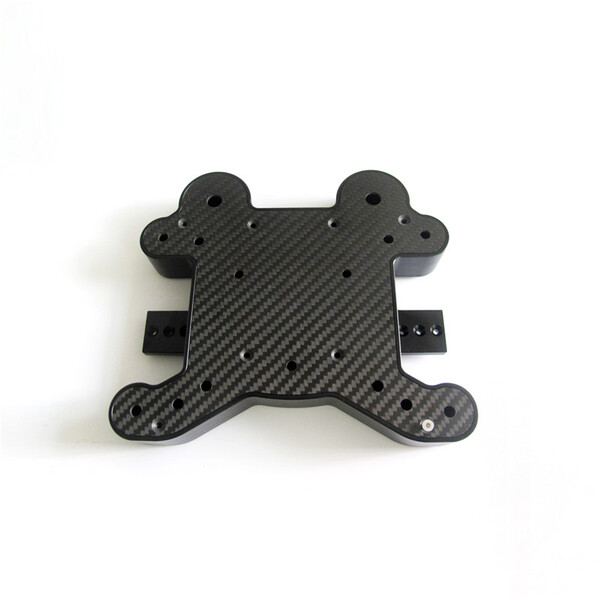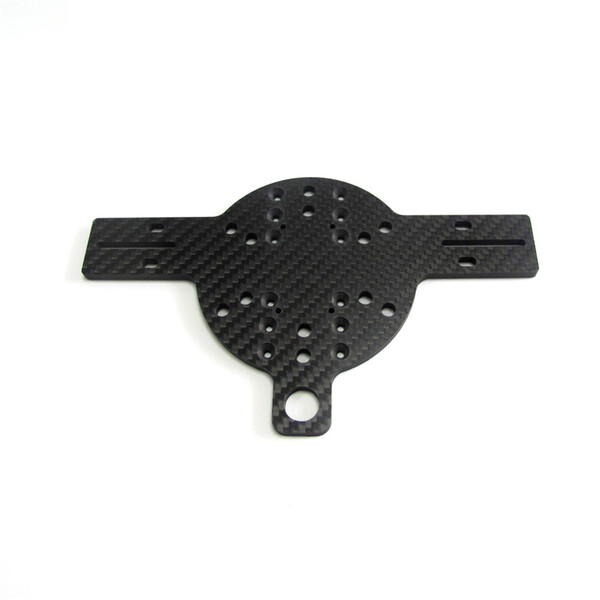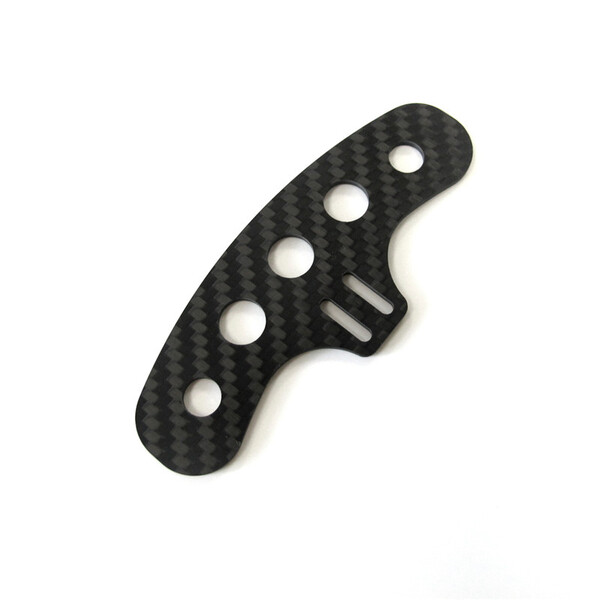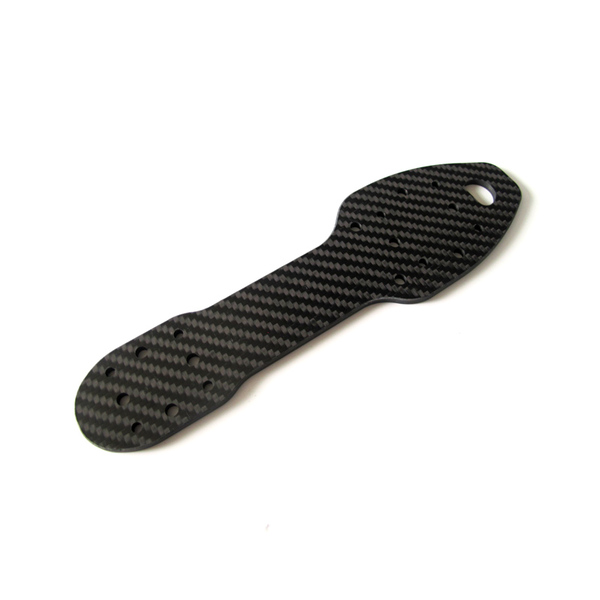Custom Carbon Fiber CNC Machining Supplier
Precision Perfected, Prices Unmatched: China Premier Carbon Fiber CNC Machining
- Competitive Price
- Fast Turnaround
- Material Certificates
- Global Delivery

Carbon Fiber CNC Machining Supplier
Seeking a trusted, efficient provider for your CNC Carbon Fiber parts?
AT-Machining stands ready to assist. With a decade of experience in bespoke CNC machining services for Carbon Fiber, we ensure your project demands are met with exceptional precision at an unbeatable price. Partner with us for assured satisfaction alongside professional CNC milling, turning, or drilling explicitly tailored to your needs!”





What is the Characteristics of Carbon Fiber
Because of the following characteristics, Carbon Fiber is the best choice for parts in various industries.
High Strength-to-Weight Ratio
Carbon fiber is remarkably strong for its size and weight. This makes it an ideal material for applications where strength is crucial, but weight must be kept to a minimum.
High Stiffness
Carbon fiber’s stiffness or modulus of elasticity is significantly higher than that of most other materials, making it suitable for precision parts and structures.
Low Thermal Expansion
Carbon fiber exhibits low thermal expansion. This means it maintains its shape and size even under significant changes in temperature, which is a crucial trait in precision components.
High-Temperature Tolerance
Carbon fiber is able to withstand high temperatures, making it useful in environments where heat resistance is important.
Corrosion Resistance
Unlike metals, carbon fiber does not rust or corrode, even in harsh weather conditions or when exposed to chemicals. This property leads to a longer lifespan for components made from it.
Excellent Fatigue Properties
Carbon fiber components can withstand repeated loads and stresses without losing their strength and rigidity, leading to a long service life.
X-Ray Transparency
Carbon fiber is X-ray transparent, making it useful in medical and scientific applications where non-interference with imaging is crucial.
overview of various Carbon Fiber
Carbon fiber grades vary in properties and cost, influencing selection based on project needs like strength, stiffness, and budget. Note, machining techniques also differ per grade, requiring careful tool choice and parameter setting for optimal results.
Also referred to as high-strength (HS), this is the most commonly used grade of carbon fiber due to its balance of strength, stiffness, and cost. It is ideal for applications where strength is crucial, but high stiffness isn’t necessary. It offers excellent tensile strength, and it is often used in aerospace, automotive, and sports equipment.
IM carbon fiber provides a good balance between the stiffness of HM fibers and the strength of HS fibers. It is typically used in applications where high strength and good stiffness are required, but the highest levels of either aren’t necessary.
HM carbon fiber is designed for applications where stiffness is more important than strength. It offers a high tensile modulus, making it ideal for applications that require significant rigidity, like aerospace components, where weight savings are paramount.
UHM carbon fiber has an exceptionally high stiffness, but its tensile strength is generally lower than that of HS or IM grades. It’s often used for specialized applications where the utmost stiffness is needed, and strength requirements are lower, such as in high-frequency vibration equipment.
While similar to standard modulus carbon fiber, some HS grades are designed to offer even higher tensile strength. These are typically used in applications that require exceptionally high strength, such as military and high-performance sporting goods.
UHS carbon fiber offers the highest tensile strength available, but often with less stiffness compared to HM or UHM fibers. It’s used in very demanding applications where maximum strength is required.
Grades of Carbon Fiber Comparison
Evaluating Key Properties and Applications to Determine the Perfect Fit for Your Project
| Carbon Fiber Type | Mechanical Properties Indicator | Thermal Properties Indicator | Chemical Properties Indicator | Application Areas Indicator | Application of Specific Case | Cost |
|---|---|---|---|---|---|---|
| Standard Modulus (SM) | Good strength, average stiffness | Good strength, average stiffness | Resistant to most chemicals | Aerospace, Automotive, Sports Equipment | Ideal for general aerospace structures | $ |
| Intermediate Modulus (IM) | Improved strength and stiffness compared to SM | Moderate thermal conductivity, Low thermal expansion | Resistant to most chemicals | Aerospace, High-performance vehicles | Aerospace, High-performance vehicles | $$ |
| High Modulus (HM) | High stiffness, average strength | High thermal conductivity, Low thermal expansion | Resistant to most chemicals | Aerospace, High-frequency vibration equipment | Useful in satellite structural components | $$$ |
| Ultra-High Modulus (UHM) | Highest stiffness, lower strength | Very high thermal conductivity, Very low thermal expansion | Resistant to most chemicals | Specialized applications with utmost stiffness needs | Perfect for high-frequency vibration equipment | $$$$ |
| High-Strength (HS) | Highest strength, average stiffness | Moderate thermal conductivity, Low thermal expansion | Resistant to most chemicals | Military, High-performance sports goods | Excellent for military-grade body armor | $$$ |
| Ultra-High Strength (UHS) | Unrivalled strength, average stiffness | Moderate thermal conductivity, Low thermal expansion | Resistant to most chemicals | Very demanding applications requiring maximum strength | Ideal for advanced aerospace applications | $$$$ |
Important Parameters Of Different Types Of Carbon Fiber
AT-Machining empowers customers with state-of-the-art Carbon Fiber materials, presenting a spectrum of choices tailored for each application. Every Carbon Fiber exhibits distinctive characteristics; selecting the most suitable material for your project is crucial.
| Tensile Strength | Compressive Strength | Elastic Modulus | Elongation at Break | Density | Thermal Conductivity | Coefficient of Thermal Expansion | |
|---|---|---|---|---|---|---|---|
| carbon fiber | 3500 MPa | 1500 MPa | 230 GPa | 1.5% | 1.75 g/cm³ | 5 W/m·K | -0.1 µm/(m·K) |
Note: These values are approximate and can vary based on the specific type of carbon fiber and the manufacturing process. For more precise data, it would be best to refer to the specifications provided by the manufacturer or supplier.
Industrial applications of Carbon Fiber
With unparalleled strength and lightness, Carbon Fiber revolutionizes sectors such as aerospace, automotive, wind energy, sports, and civil engineering with its superior, versatile applications.

Aerospace
Carbon fiber is used in aircraft structures for its strength-to-weight ratio, reducing fuel consumption while increasing durability.

Automotive
High-performance cars utilize carbon fiber for lightweight, strong parts, enabling faster speeds and improved fuel efficiency.

Civil Engineering
In bridge, building, and infrastructure construction, carbon fiber reinforcement provides added strength and durability.

Sports Equipment
Carbon fiber is a common material in manufacturing various sports gear, offering lightweight strength for optimal performance.

Wind Energy
The durability and lightness of carbon fiber make it ideal for the manufacturing of wind turbine blades.

Medical Devices
Carbon fiber's biocompatibility, lightweight, and radiolucency make it an ideal choice for prosthetics and medical imaging tables.

Consumer Electronics
Carbon fiber is used in gadgets like laptops and smartphones for its lightweight and strength, improving portability and durability.

Marine
Carbon fiber is used in yacht and boat construction for its high strength, lightweight, and resistance to corrosion.

Defense
The defense industry utilizes carbon fiber for various applications, including lightweight, durable body armor and components for military vehicles.
How is Carbon Fiber CNC machining
CNC machining is an advanced process of transforming Carbon Fiber into custom parts with precision and efficiency.
This begins with a CAD-produced 3D model converted into a CNC program that guides the machinery.
Specialized techniques and tools are employed during machining to prevent delamination, splintering, and heat generation, which can affect the carbon fiber’s characteristics. We enhance machined part quality and tool longevity by using specific drills, end mills, and router bits, along with optimal cutting speeds, coolant application, and climb milling strategies. The culmination of this process is a tailor-made, precision-machined Carbon Fiber part fitting exact design specifications.
This machining process offers flexibility for numerous applications and is suitable to both bespoke pieces and high-volume production.
Our Tolerances for Carbon Fiber CNC Machining
Our commitment to quality and precision stands out. With advanced measuring equipment, highly skilled QC inspectors, and a relentless pursuit of extreme tolerance, we offer custom CNC machining parts of the highest standard. Our expertise makes us an industry-trusted supplier you can rely on.
- Grinding: general tolerances of ±0.02mm, can achieve ±0.01mm with a surface finish of N2/N3
- CNC Turning: general tolerance of ±0.03mm, can achieve ±0.01mm with a surface finish of N4/N5
- CNC Milling: general tolerance of ±0.03mm, can achieve ±0.01mm with a surface finish of N4/N5
- CNC Milling: bed capacity of 1000mm in X and 510mm in Y, spindle speed of 12,000 rpm
- CNC Turning: capabilities of 250mm diameter with power tooling
- Our CNC machine equipped with synchronized rigid tapping for perfect internal threads
Tips for Designing and CNC Machining Carbon Fiber

Designing and CNC machining carbon fiber parts can be challenging due to the material’s high strength-to-weight ratio, rigidity, and potential to fray or delaminate. Here are some tips to help you effectively design and machine carbon fiber:
Understand the Material
Carbon fiber has unique properties, with strength largely dependent on the fiber orientation. It’s crucial to understand the material’s properties and how they influence your design and machining process.
Design For Machining
Avoid sharp internal corners that are challenging to machine. Utilize uniform wall thicknesses to minimize the risk of breakage and consider the fiber direction in your design.
Optimize Cutting Parameters
To prevent heat build-up and material damage, use appropriate spindle speeds, feed rates, and cutting depths. Climb milling is often preferred over conventional milling to reduce the risk of delamination and fraying.
Coolant and Dust Extraction
Use coolants to prevent heat buildup and prolong tool life. Ensure a good dust extraction system is in place as carbon fiber dust is harmful if inhaled.
Post-processing
Expect some level of post-processing. This may include sanding to remove rough edges and applying a sealant to prevent future delamination or fraying.
Gallery of Our Carbon Fiber CNC Machined parts
We machine rapid prototypes and low & large-volume production orders for customers in multiple industries: medical devices, aerospace, automotive, defense, electronics, hardware startups, industrial automation, machinery, marine and robotics, and many more.





Frequently Asked Questions
The primary benefits include the ability to produce complex shapes with high precision, the strength and lightness of carbon fiber, and the speed and efficiency of the CNC machining process.
Yes, carbon fiber dust can be harmful if inhaled, and therefore, a good dust extraction system is necessary. Also, proper personal protective equipment should be worn during the machining process.
High-Modulus carbon fiber offers higher rigidity but is less durable, while High-Strength carbon fiber offers more durability but less rigidity. The choice depends on your specific application requirements.
Proper tool selection, optimized cutting parameters, and the use of coolants can help minimize the risk of delamination during Carbon Fiber CNC Machining.
Yes, CNC machining is suitable for both one-off custom parts and high-volume production, making it a versatile manufacturing choice.
Summary
Beyond Carbon Fiber, we offer CNC machining for a wide range of metals and plastics. This includes, but is not limited to, aluminum, steel, brass, copper, stainless steel, POM, PEEK, Nylon, PVC, and ceramics. Each material has unique attributes, strengths, and limitations, allowing for a tailored selection based on your project needs.
If a dependable partner for bespoke CNC machined parts is what you seek, look no further. AT-Machining promises speedy prototyping, superior-quality CNC components, and swift delivery. Get in touch with us today.
